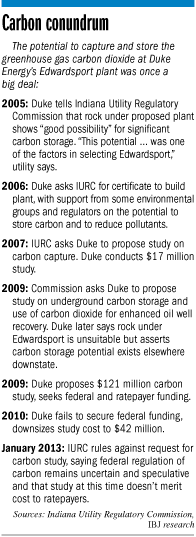Subscriber Benefit
As a subscriber you can listen to articles at work, in the car, or while you work out. Subscribe NowState regulators have rejected Duke Energy’s request to conduct a $42 million study on what to do with carbon dioxide produced by its Edwardsport coal gasification plant slated to go online this year.
The Jan. 23 ruling by the Indiana Utility Regulatory Commission ends three years of litigation and spares Duke’s 780,000 Indiana customers from paying more toward a plant already saddled with $1.5 billion in cost overruns.
 Duke estimates the $3.6 billion electric generating station will result in a 14- to 16-percent increase in residential rates in exchange for less pollution and continued use of Indiana coal.
Duke estimates the $3.6 billion electric generating station will result in a 14- to 16-percent increase in residential rates in exchange for less pollution and continued use of Indiana coal.
It was coal gasification’s potential to easily capture the greenhouse gas carbon dioxide that helped Duke win public and regulatory acceptance for Edwardsport.
“The original justification for this whole thing was just quietly swept away and dismissed,” Kerwin Olson, executive director of Citizens Action Coalition, said of the commission’s decision.
In 2009, the commission ordered Duke to propose a study on ways to dispose of carbon deep underground and for enhancing recovery of oil and gas from wells.
At the time, Congress and the Environmental Protection Agency were actively proposing to regulate manmade carbon emissions, which some scientists blame for global warming.
But in its ruling last month, the IURC noted that Congress still hasn’t passed carbon legislation and that EPA regulations still appeared to be “speculative in terms of both timing and result.”
The commission also cited uncertainties regarding the technical feasibility of storing vast amounts of carbon dioxide deep underground—known as sequestration—and of the prospect for transporting the gas via pipeline.
Also, it noted Duke was unsuccessful in landing federal funding for the study.
“We conclude that the evidence does not sufficiently support a finding that the measurable benefits of the carbon sequestration study merit the material cost to ratepayers at this time,” the commission wrote.
Angeline Protogere, spokeswoman for Duke Energy Indiana, said that, given the number of years that have passed, it makes sense to re-evaluate study plans “once there’s more clarity around carbon regulation.
“This order positions us to come back to the commission in the future once we have more certainty around those issues,” added Protogere.
The Office of Utility Consumer Counselor had sought to cap Duke’s carbon study cost at $36.6 million. The agency said it still sees the value in researching the potential for carbon capture and sequestration at Edwardsport. But it echoed the commission’s finding that there remain a number of regulatory and technical uncertainties.
“In our view, the costs Duke was seeking in this case were unreasonable and premature,” said Anthony Swinger, spokesman for OUCC.
Like many aspects of the 618-megawatt plant, carbon dioxide capture and storage has been controversial.
In 2006, when Duke was still seeking support for the plant, it told regulators that preliminary studies showed “a good possibility that a significant amount of sequestration (storage) potential exists within an area below and immediately surrounding the site.”
The idea was to inject carbon dioxide into a liquid and then pump it under high pressure into sandstone formations thousands of feet below.
Immediately, critics raised concerns that the CO2 solution could migrate into drinking water supplies. They noted the Edwardsport plant is in a seismic zone, although a geologist hired by Duke downplayed the risk of an earthquake allowing carbon to escape.
The commission approved construction of the Edwardsport plant, which had the support of former Gov. Mitch Daniels. He wanted to protect Indiana’s coal industry, which is threatened by any number of Obama administration strategies to drastically slash air pollution from conventional coal-burning power plants.
The 618-megawatt plant is touted as one of the world’s most efficient coal-based power plants. Duke said it will emit less sulfur dioxide, nitrogen oxides and particulates than the ancient plant it replaces while generating 10 times the amount of electricity.
Duke Chairman Jim Rogers, at the 2008 Indiana Carbon Capture & Sequestration Summit, reiterated Duke’s intention to “decarbonize” its entire fleet of plants by 2050, and said that is why the company was moving forward with Edwardsport.
But the following year, Duke told the commission that geological data from an injection well drilled to dispose of treated wastewater “was not promising in terms of the required characteristics needed for carbon sequestration.”
Instead, Duke proposed investigating other potential sequestration sites within 150 miles of the plant.
Duke proposed a $121 million study, saying it intended to mitigate ratepayer impact by seeking federal funding toward the study. But when federal funding fell through, Duke scaled back the proposed study to $42 million.
At the same time, costs for the plant were rising from the $1.9 billion the commission initially OK’d. Last April, Duke, the OUCC and industrial ratepayers reached a settlement capping at $2.65 billion what customers will have to pay on construction.
The plant’s growing price tag has been blamed on design changes, rising materials costs and disagreements between Duke and its contractors. CAC, Sierra Club and other groups accuse Duke of gross mismanagement as part of an appeal of the settlement they filed last month with the Indiana Court of Appeals.
The plant converts coal into a gas, which is then cleaned of pollutants and burned in electric-generating turbines.
“It’s important to remember that the plant produces about 40 percent less carbon dioxide per net megawatt-hour than the facility it replaces,” said Duke’s Protogere.•
Please enable JavaScript to view this content.
